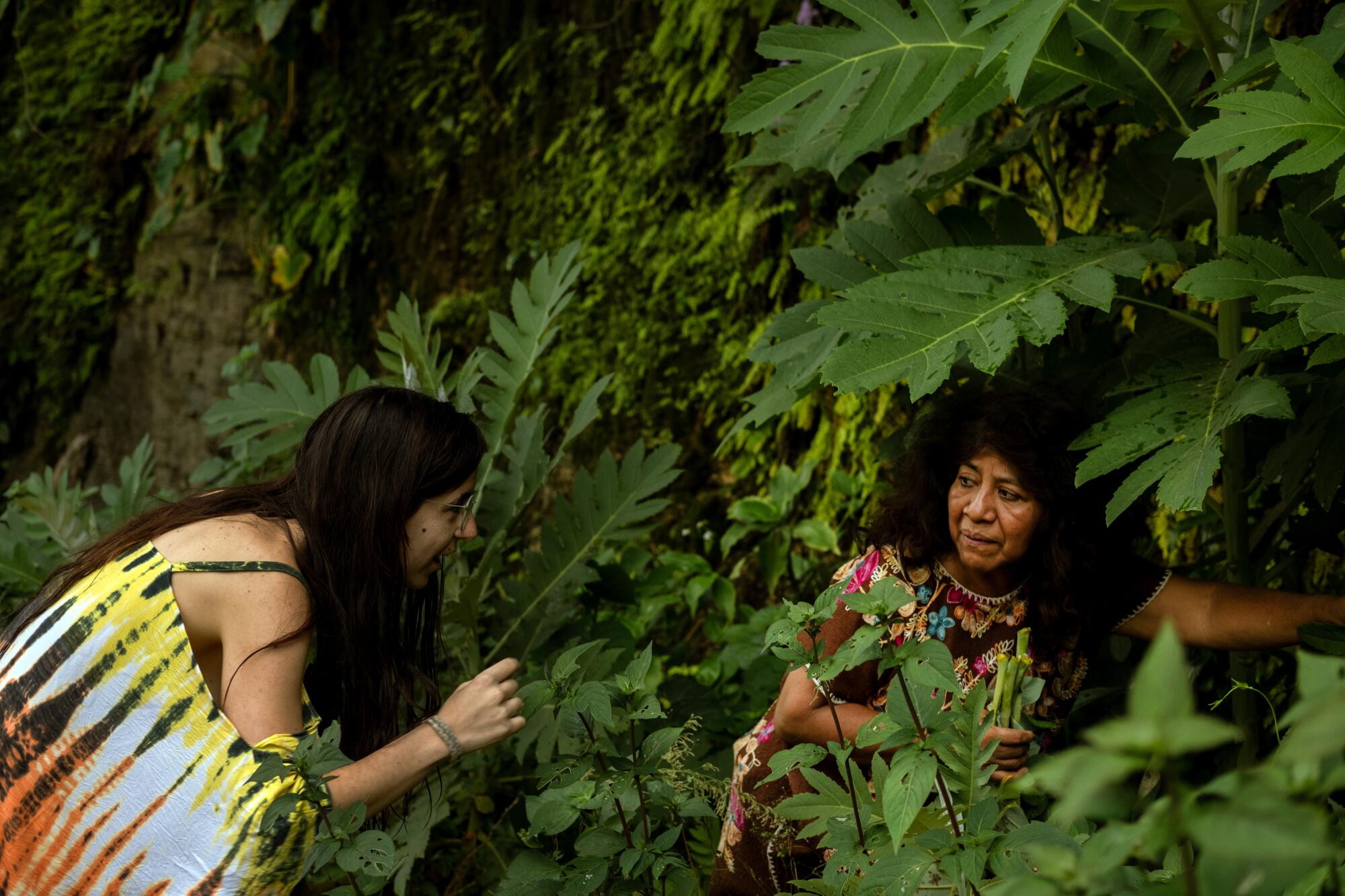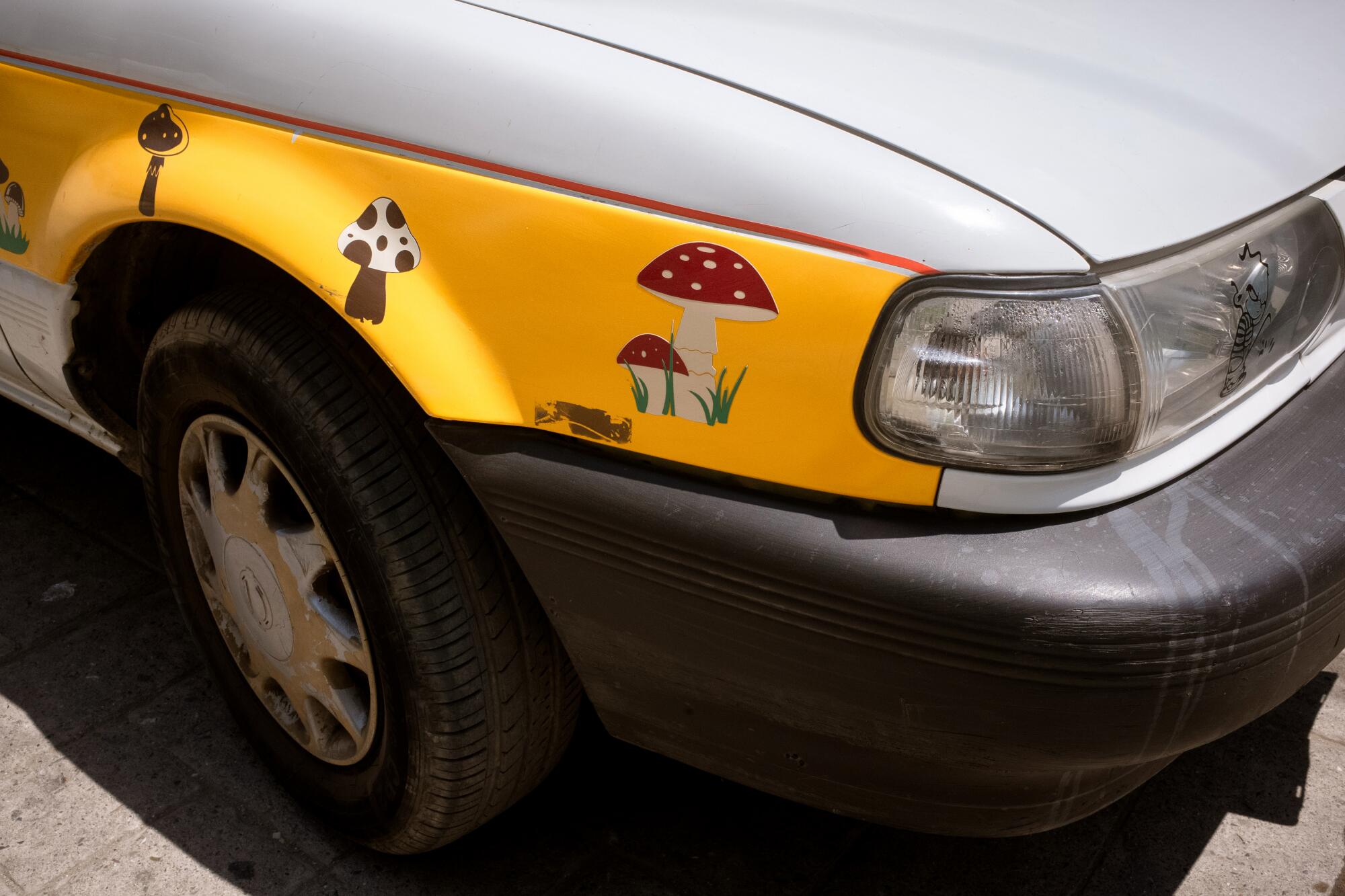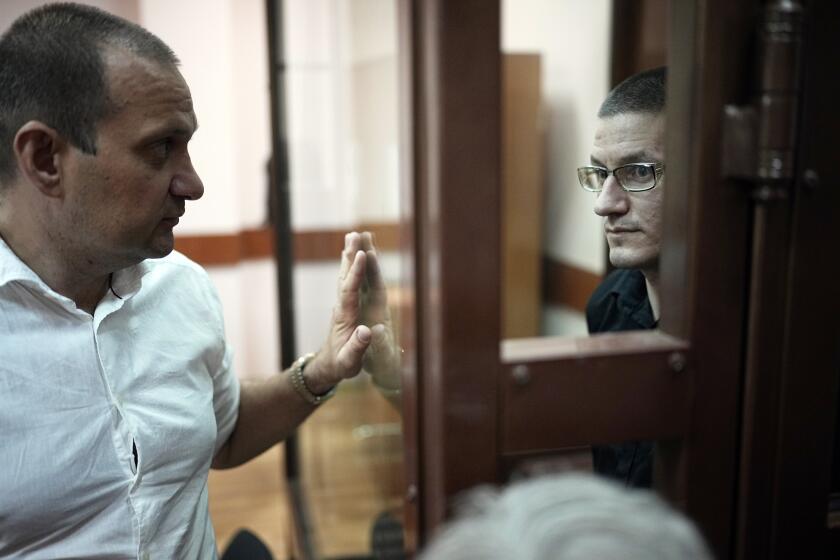
Alejandrina Pedro Castañeda opened a brown paper package and pulled out a handful of magic mushrooms, which many residents of this Indigenous Oaxacan town tenderly refer to as “child saints” or “the little ones that sprout.”
Then she handed each of her six visitors — who had driven seven hours from Mexico City and paid up to $350 apiece for a healing retreat — a generously sized portion, prompting a few dubious looks.
It was nighttime, and the guests were sitting in a hut that was barely illuminated by two candles, making it difficult for them to see what they were about to eat.

Pedro Castañeda has used mushrooms in her healing practice for years and was comfortable stepping outside as the group crunched slowly in silence.
One person said the fungi tasted like stale popcorn. Another tasted dirt.
The healer returned a few minutes later.
“Now we’re starting the trip,” she said. “Let’s go to work.”
Indigenous communities in Mexico have long considered psychedelic mushrooms to be intermediaries to the spiritual world. But their growing popularity outside of Mexico has spurred a debate over who should have access to them and whether science and Indigenous medicine can or should be reconciled.
Some Indigenous healers are courting tourists. Scientists interested in their chemical properties have been studying mushrooms in hopes of developing treatments for depression and other mental health problems. And growing demand from recreational users has fueled a thriving black market.

Currently, the fungi can only be used in Indigenous rituals or in government-approved research. But a senate bill proposes making psilocybin, a psychedelic compound in the mushrooms, more widely available.
In addition to making psilocybin available to anyone with a doctor’s prescription, the bill would permit therapy that uses the actual mushroom that a government office of traditional medicine would help regulate. It also calls for scientific research on Indigenous medicine and providing compensation to Indigenous people for “patents” involving their traditions.
The bill’s supporters say that they’re trying to protect Indigenous medicine by making sure the traditional use of magic mushrooms is enshrined into law.
But the prospect of expanding the availability of magic mushrooms has created friction within Indigenous communities that have used them for centuries. Will the spirituality associated with this traditional medicine be lost?
::
Magic mushrooms have been used in Mesoamerican religious rituals since pre-Hispanic times. A mural from the ancient city of Teotihuacán, just outside Mexico City, shows the Toltec rain god Tlaloc with two figures alongside him holding mushrooms that have risen from where his raindrops fell. A Franciscan missionary documenting 16th century life in New Spain referred to the mushrooms as the “flesh of the gods.”
But it wasn’t until the 1950s that a New York banker and mushroom enthusiast named R. Gordon Wasson made Mexico’s magic mushrooms famous — perhaps too famous — in the Western world.
On a trip to Huautla, in southern Mexico, he ate mushrooms with Indigenous Mazatec healer María Sabina and wrote about the experience in a 1957 article for Life magazine titled “ Seeking the Magic Mushroom.” The story inspired thousands to travel to Huautla — some seeking out Sabina. The Mexican press described the foreigners as addicts, and the military ultimately set up a checkpoint on the road to Huautla to try to block the outsiders.
In July 1970, Reuters reported: “Hundreds of hippies are braving imprisonment and fines to penetrate this mushroom paradise in the State of Oaxaca, where the authorities are conducting a drive against mushroom eaters.”

Wasson said he felt guilty about the crowds in a New York Times op-ed published later that year. A “humble out-of-the-way” town had been overrun by “a torrent of commercial exploitation of the vilest kind.”
“The old ways are dead,” he wrote, “and I fear that my responsibility is heavy, mine and María Sabina’s.”
In an interview toward the end of her life, Sabina described how some outsiders would take the mushrooms “at whatever time and whatever place” and “don’t use them to cure themselves of a sickness.”
“From the moment the foreigners arrived to search for God,” she said, “the saint children lost their purity.”
In the mid-20th century, psilocybin was classified as a Schedule I substance in the U.S. — which put the kibosh on research. But interest in scientific research on mental health and psilocybin was rekindled in the 1990s.
::

Psilocybin is thought to boost neuroplasticity, the brain’s ability to form new neural connections, and research indicates that it may be successful in treating depression, anxiety and substance abuse. Parts of the United States have legalized or decriminalized the substance. (Oakland decriminalized magic mushrooms in 2019.)
“That plasticity enhancement may allow people to shift how their brain is functioning into a mode that’s more helpful, more adaptive, that’s going to promote mental health,” said Greg Fonzo, who co-directs the Center for Psychedelic Research & Therapy at the Dell Medical School at the University of Texas at Austin.
Some people who ingest magic mushrooms report overwhelming feelings of joy or the presence of family. Others have said they feel deeply sad or that they are having an out-of-body experience.
The risk of a lethal overdose is considered very low, Fonzo said. What’s more common is having a difficult experience or a “bad trip” due to anxiety.
Pedro Castañeda, who compares the bill with a birth certificate, supports the legislation, insisting the world must not forget that the Mazatecs, as well as other Indigenous communities, have preserved rituals with magic mushrooms for centuries.

“The medicine is not protected now. It’s out of control,” she said. “Everyone has it in their home, like cannabis,” she said, referring to black market purchases. “What we need is a record that says the Mazatecs are the custodians, the Mazatecs are the ones that for millennia have defended the medicine.”
But other Mazatecs in Huautla are worried about appropriation and misuse, that traditions associated with Indigenous culture will be disrespected as increasing numbers of people rush to pick up their prescriptions.
In an Indigenous mushroom ceremony, the healer will use mushrooms to communicate with their spiritual world to inquire about a patient’s illness. A patient may also experience revelations.
If the bill passes, “It’ll be taken like an aspirin,” said Isaias Escudero Rodriguez, a local doctor. It will no longer have the “spirituality that it carries for us.”
::
The push to legalize magic mushrooms in Mexico dates back to the early days of the pandemic. Alejandra Lagunes, 52, a senator in Mexico’s national congress, started to experience anxiety attacks that were reminiscent of the severe depression she suffered in her 20s. The depression from decades ago, she said, was resolved after she took ayahuasca — a psychoactive brew made from the Amazonian Banisteriopsis caapi vine — with an Indigenous healer.
Lagunes researched psychedelics and introduced legislation in November to increase access to magic mushrooms while recognizing the long tradition of Indigenous medicine. She hopes it opens the door for non-Indigenous Mexicans to learn from Indigenous practices.
The initiative has supporters at Mexico’s National Institute of Psychiatry, where scientists have government permission to investigate the potential therapeutic effects of magic mushrooms.
Jesús María González Mariscal, a clinical psychologist in Mexico City who has advised the senator, said much can be learned from traditional medicine, including the importance of companionship in Mazatec mushroom ceremonies. These ceremonies occur at night under the guidance of a healer with candles, flowers, incense and an altar with Catholic images. A patient’s family members may accompany them.
The result, Mariscal said, “is a space of care and protection so a person can explore their inner world in a context that’s safe, trustworthy and ethical” — and that’s what Mexico City psychotherapist Oscar O’Farrill is trying to teach his students.

O’Farrill runs a master’s and doctoral degree program affiliated with the National School of Psychologists and Experts of Mexico where his approximately dozen students listen to Indigenous guest speakers talk about traditional medicine. He schedules group therapies in his home, a two-story house where a large container on his kitchen counter has powder from lion’s mane, a non-psychedelic mushroom, that he takes with his morning coffee. Indigenous healers have led his students through ceremonies with mushrooms, peyote and bufo, the smoked secretions of a Sonoran desert toad.
“Psychiatry in this moment can’t understand what psilocybin is if it doesn’t understand all the aspects of the customs of Indigenous people,” he said. “Like it or not, the mushrooms have a spirit.”
But Eros Quintero, a biologist who co-founded the Mexican Society of Psilocybin in 2019, said he would have preferred that Indigenous communities were not singled out in the bill, that psilocybin simply be reclassified.
Indigenous people, he said, may not view illness through the prism of Western science. In Mazatec culture, for example, people may believe that a person fell ill because they walked through a cave where spirits are thought to reside or broke a communal rule.
“They have their own traditions and their own way of seeing things, and what we see is that there are few who are interested in what we’re interested in with psilocybin,” he said.
::
Huautla presents itself as a place for the mushroom-seeker.
Taxis decorated with images of small mushrooms speed up and down narrow mountain roads that are lined with tin-roofed houses. In the summer, when mushrooms are in season, locals wait by a bus terminal to offer the fungi to tourists. Prices vary, but a dozen pairs of mushrooms (they’re sold by the pair) may cost $25 and a ceremony can cost $90 or more. After mushroom season, the fungi are often preserved in jars with honey.

Several signs announce the home of the family of María Sabina — who died in poverty in 1985 but whose life has since been celebrated in Mexican culture. Her descendants, who live on the property where Sabina once resided, maintain a small museum filled with portraits of the healer and sell mushroom-themed crafts.
Anselmo García Martínez, a farmer and a great-grandson of Sabina, says he was about 6 when he tried mushrooms for the first time during a ceremony with relatives who were accompanying a sick family member. (Many other locals say they first consumed mushrooms as children.)
Like some other residents, he said he didn’t mind if mushrooms are allowed outside Indigenous rituals because the general public already has access to them through the black market.
But he issued a reminder: “For us, for the Mazatecs, it’s something sacred.”

Lagunes said she’s invited Indigenous people to the forums she has sponsored, and last year she posted a video on the social media platform X that showed her with several healers and indigenous people in Huautla. They presented her with a baton that she said she’d carry to “bring the voice and knowledge of ancestral medicine to the place that it deserves.”
But some opponents have said that the Mazatec people haven’t been properly consulted on whether the bill should move forward, reminding supporters that, for the moment, there is no infrastructure to make it happen. Santos Martínez, one of the founders of Caracol Mazateco, a civil society group focused on preserving Mazatec culture, agrees there hasn’t been enough outreach to the Mazatecs.
Martinez said his experiences with magic mushrooms transformed his life. As a medical student working at a clinic in the state of Puebla, he fell into a depression after seeing patients suffer from inadequate care. He returned to his community in Huautla, where he participated in mushroom ceremonies, hoping they would help him find direction in his life.
During the ceremonies he felt happy and had visions of family members, including his grandfather. “It was as if he was saying, ‘adelante, hijo,’” he said, or, “go forward, son.”
Francisco Javier Hernandez García, a Huautla healer who leads mushroom ceremonies for tourists almost daily at some points of the summer, fears that mushrooms will “lose respect” if they are legalized for therapy outside of the Indigenous context.



Francisco Javier Hernandez Garcia is a Huautla healer who leads mushroom ceremonies for tourists almost daily at some points in the summer. He fears mushrooms will “lose respect” if they are legalized for therapy.
Like others, he spoke about mushrooms as carrying wisdom.
“They sprout because they are waiting for that person,” he said, referring to the one who will eat them. “They already know who carries problems.”
::
In mid-April, O’Farrill organized a trip for six people — including himself — to visit Pedro Castañeda for the healing retreat. Two people, a man who works for a Wall Street asset management firm and a woman training to guide people during mushroom trips, had flown in from the U.S. A mother and daughter, both psychologists, and a literary editor were from Mexico.
They spent three days at the home of Pedro Castañeda, who lives with eight dogs in a house that has several floors under construction. She hosts a mushroom ceremony for locals or tourists once or twice a week and said that the “great spirit” tells her how many mushrooms to give each person.
The members of O’Farrill’s group had individual therapy sessions with Pedro Castañeda in which she asked them about their insecurities. After her guests ate mushrooms, Pedro Castañeda asked several of them to sing. At one point, the editor began to suddenly cry, and the younger psychologist said she felt pain, prompting the healer to rigorously brush her with a feather in a cleansing ritual. A few minutes later, the psychologist said she was having visions of “injustice in jail.”

The next morning, the group hiked — mostly barefoot — the Mountain of Adoration, which the Mazatecs consider sacred.
At the top of the mountain, which overlooked Huautla, the healer gave each person cacao beans to leave as an offering, giving thanks for the previous night. They placed them on a tower of rocks jutting out from the mountain, next to many little mounds of cacao left earlier by other visitors.
More to Read
Start your day right
Sign up for Essential California for news, features and recommendations from the L.A. Times and beyond in your inbox six days a week.
You may occasionally receive promotional content from the Los Angeles Times.






